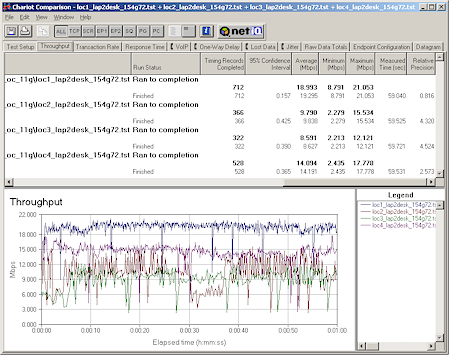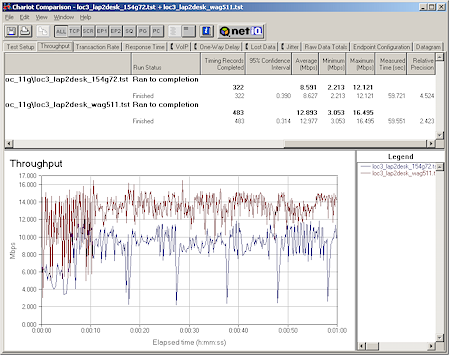Introduction
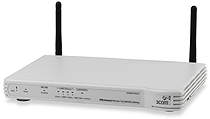
| 3Com OfficeConnect Wireless 11g Cable/DSL Gateway | |
|---|---|
| Summary | PRISM-based 11g router with basic feature set. Supports WPA – Replaced by 3CRWE554G72T model with same features |
| Update | None |
| Pros | •Supports WPA • High routing throughput |
| Cons | • Mediocre wireless performance • Limited wireless configurability • Port forwarding & filtering not day/date schedulable |
3Com’s OfficeConnect Wireless 11g Cable/DSL Gateway is essentially an 802.11g version of 3Com’s now-discontinued 11b-based OfficeConnect Wireless Cable/DSL Gateway. I found that it covered the essentials, but didn’t have anything that separated it from the rest of its peers.
Basic Features and Construction
The OfficeConnect 11g is about the size of a slim hardcover book and has a plastic shell cover (with internal metal shield) that’s mated to a metal bottom frame. It has all its indicators on the front (Alert, Power, WLAN, LAN Status and Cable/DSL), connectors on the back and screw-head mounting slots on the bottom for wall mounting. The dual dipole antennas are hard-wired, but movable in all directions.
The indicators are all combination Link/Activity and change color to indicate 10 or 100Mbps operation (except for the WLAN indicator). They’re fairly small, though, and you pretty much have to view then straight-on to see what’s going on. Both the WAN and LAN ports are 10/100 auto MDI / MDI-X, which willl figure out how to connect to whatever you plug in – whether you use a Normal or Crossover cable. Although there’s no hardware reset switch, you can perform a reset-to-factory-defaults by powering off the router, plugging a normal UTP cable into the WAN and any LAN port and powering up. (First time I’ve seen this trick!)
Unlike its predecessor, which was based on the ADMtek 5106 Home Gateway Controller, the OfficeConnect 11g is based on GlobespanVirata’s ISL3893 WiSOC (Wireless System-on-a-Chip). Figure 1 shows a very clean board design, with flash memory, RAM, ADMtek 6996 5 port 10/100 switch and PRISM GT-based 11g radio built right onto the main board.
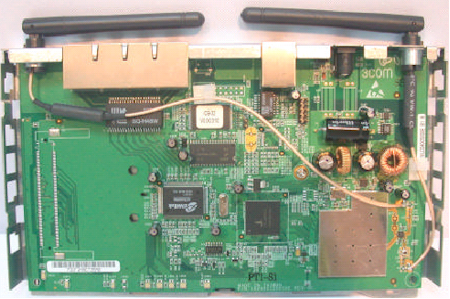
Figure 1: Internal view
Both products are actually manufactured by Accton, which is the parent company of SMC Networks and which also OEM’s some of Microsoft’s wireless products.
Setup and Administration
Administration is entirely web-browser based, and very responsive with setting changes accepted within a few seconds. When you first log into the router, you’ll be prompted to pick a country so that the proper wireless channel selections are presented to you.
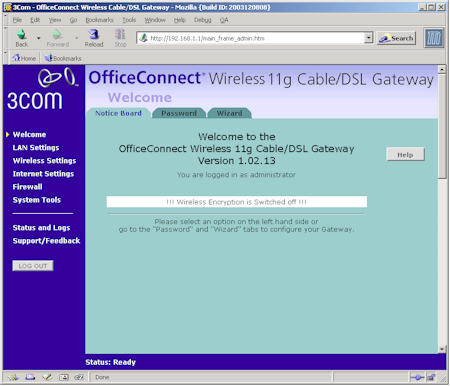
Figure 2: Welcome screen
The Setup Wizard then launches to walk you through setting up the WAN (Internet) side of the router. The wizard doesn’t auto-detect your connection type, but does ask (but not require) you to change the admin password, something I think should be standard with all “wizards”. You also can go directly to the Internet settings page (Figure 3) to set up your WAN connection.
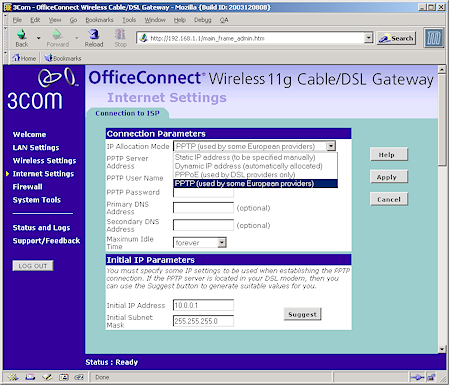
Figure 3: Internet settings
The user interface is generally well-organized and has some interesting features. For example, like many other routers, the OfficeConnect lets only one administrator connect at a time and displays a message telling you the IP address of the current administrator. But unlike other products, you can click a button on that screen and be taken to the login screen where you login and disconnect the other administrator! One thing I found very annoying was the router’s insistance on logging me out after about what seemed like one minute of inactivity, and the inability to change that setting!
Remote admin is disabled by default, but once turned on, can be limited to a single, range, or any IP address. However, the port used for remote admin (8000) can’t be changed.
Firewall Features
The OfficeConnect uses a NAT + SPI firewall and supports one DMZ host. Static inbound port forwarding (Virtual Servers – Figure 4) can be done with single ports, port ranges or combinations of the two, but you can’t specify TCP or UDP protocols.
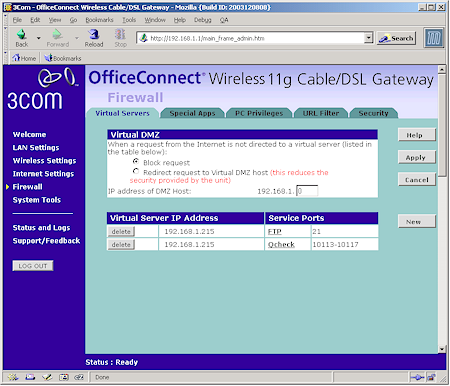
Figure 4: Virtual Servers
I also found that “Loopback” isn’t supported for virtual servers.
The Special Applications feature (Figure 5) also supports single ports, port ranges and combinations, plus the ability to specify a single outbound trigger port. Curiously, Virtual Servers setups can’t be temporarily disabled (you must delete them to close the port(s), but Special Applications can.
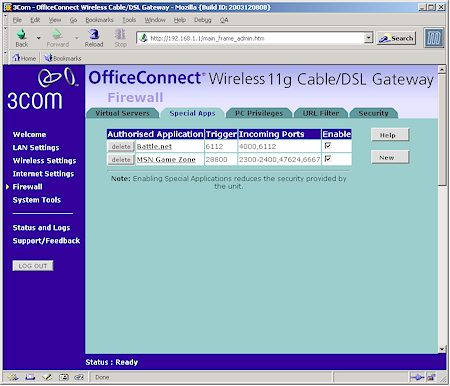
Figure 5: Special Applications
Universal Plug and Play (UPnP) is supported, but disabled by default (the way I like to see it). If you do enable it, you have no control over its NAT Traversal feature and ports opened by it aren’t shown in the router’s admin interface.
Control over outbound Internet access (port filtering) is provided by the PC Privileges feature.
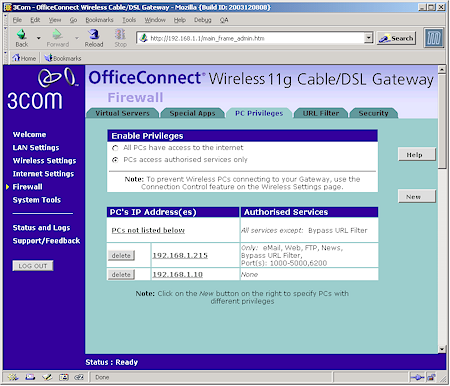
Figure 6: PC Privileges
Figure 6 gives you a flavor for the interface, and Figure 7 shows the screen for adding a privilege. Note that privileges can be defined only for individual IP addresses and all IP addresses other than those with specific privileges set.
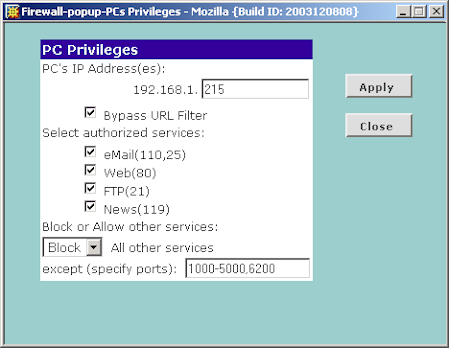
Figure 7: Adding a PC Privilege
Note also that none of the firewall features is schedulable, a handy feature found on many competitive products.
The Status page provides a nice summary of many of the router’s settings, and contains a button for doing a release / renew on the WAN connection.
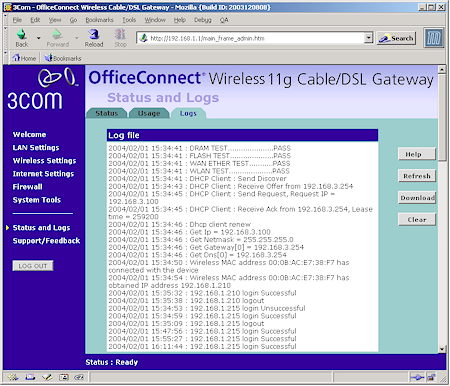
Figure 8: Logging
Figure 8 gives you a flavor for what the Log page contains. It doesn’t include website traffic logging, but does show wireless client DHCP leases. There are no emailed alerts, but, according to the User Guide, the front panel Alert light will be lit if the router “has detected a hacker attack from the Internet and has prevented it from harming your network”.
Routing Performance
Routing performance is right up there with current-generation routers at just under 36Mbps average for LAN to WAN. WAN to LAN clocked in at a slower, but still plenty fast 25Mbps, probably due to the extra processor poop needed for SPI.
Routing Performance Test Results
| Test Description | Transfer Rate (Mbps) | Response Time (msec) | UDP stream | |
|---|---|---|---|---|
| Throughput (kbps) | Lost data (%) | |||
| WAN – LAN | 24.7 | 1 (avg) 1 (max) |
500 | 0 |
| LAN – WAN | 35.5 | 1 (avg) 1 (max) |
500 | 0 |
| Firmware Version | V1.02.13 | |||
See details of how we test.
Wireless Details
Figure 9 shows the wireless feature set is very basic, letting you set just SSID, channel and whether you’d like the SSID to be broadcast. You do get, however, the ability to turn off the radio, again, something I’d like to see standard in wireless routers.
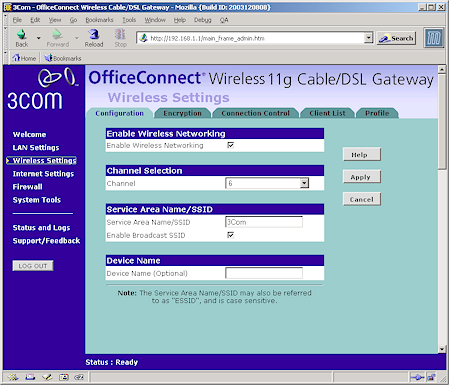
Figure 9: Wireless settings
You don’t get the ability to control the transmit rate, set the base supported rate, control transmit power, or force the router mode, i.e. 11b or 11g. You also can’t disable 802.11b protection and it doesn’t look like GlobespanVirata’s 11g throughput-enhancing Nitro technology is supported, or at least its control isn’t exposed to the user.
The only wireless monitoring you get is the ability to see the MAC address and transmit rate of associated (connected) clients.
Security features include 64 or 128 bit WEP encryption and support for Wi-Fi Protected Access (WPA). Both WPA-PSK and WPA “Enterprise” modes are supported, with the ability to specify primary and secondary RADIUS servers in the latter mode. WEP keys can be entered in hex, ASCII, passphrase and “3Com Encryption String” forms and are stored in cleartext and maintained through a disable / enable cycle.
Tip: Current documentation says that WEP and WPA are simultaneously supported. However, current firmware has removed this feature and either WEP or WPA must be chosen.
MAC address-based Association (Connection) control is also available, but when enabled, offers only an Allow (vs. an Allow / Block) option. 3Com does provide a handy pick-list of currently associated clients that eases the task of building the list, but import / export of the list isn’t supported.
Wireless Performance
Frankly, I wasn’t that impressed with the OfficeConnect 11g’s wireless performance.
NOTES:
• WinXP Zero Config utilty was used so “Signal Quality” readings were not available
• Testing was done with a 3Com OfficeConnect Wireless 11g Cardbus client card in a WinXP Home Dell Inspiron 4100 laptop
Figure 10: Four location throughput wireless performance
(click on the image for a full-sized view)
Figure 10 shows an average top throughput just over 19Mbps, which is about par for PRISM-based 11g products, but 15 – 20% below the average top speed of 22 – 24Mbps that I’ve seen from Broadcom or Atheros-based products.
My Location 1 test runs with 128 bit WEP and WPA-PSK enabled averaged 18.5 and 18.2Mbps respectively compared to 19.3Mbps with no encryption. Since these results are within 5% of each other, worst case, you have little to lose and a lot to gain by running WPA, or at least WEP.
Signal strength seemed to fall off pretty quickly, with my same-floor, two wall Location 2 test showing a drop from 5 to 2-3 bars (using XP Zero Config) and connection speed from 54 to 24-48Mbps. I was curious to see whether this was due to the router, 3Com 11g client card or both, so I ran a second Location 3 test using an Atheros-based NETGEAR WAG511 card [reviewed here].
Figure 11: Location 3 throughput – 3Com 3CRWE154G72 vs. NETGEAR WAG511
(click on the image for a full-sized view)
Figure 11 shows that the WAG511 improved performance by about 50%, but with similar throughput variation, which I’d have to say is due to the router’s radio.
My bottom line is that I wouldn’t recommend the combination of router and 3Com 11g card if you need to go through a lot of walls or long(er) distances – especially since you can’t upgrade the OfficeConnect’s antennas!
802.11g Wireless Performance Test Results
| Test Conditions
– WEP encryption: DISABLED |
Firmware/Driver Versions
AP f/w: |
||||
|---|---|---|---|---|---|
| Test Description | Signal Quality (%) | Transfer Rate (Mbps) | Response Time (msec) | UDP stream | |
| Throughput (kbps) | Lost data (%) | ||||
| Client to AP – Condition 1 | 0 | 19.3 [No WEP] 18.5 [w/ WEP] |
1 (avg) 2 (max) |
500 | 0 |
| Client to AP – Condition 2 | 0 | 9.8 | 1 (avg) 2 (max) |
500 | 0 |
| Client to AP – Condition 3 | 0 | 8.6 | 2 (avg) 25 (max) |
500 | 0 |
| Client to AP – Condition 4 | 0 | 1 | 2 (avg) 14.2 (max) |
500 | 0 |
See details of how we test.
Wireless Client
Since standalone reviews of wireless cards don’t seem to get much interest, I’ll include a mini-review of 3Com’s OfficeConnect Wireless 11g PC Card while I’m at it. I’ve covered the card’s performance in the previous section, so my comments here are mainly directed at the 3Com Wireless Card Manager.
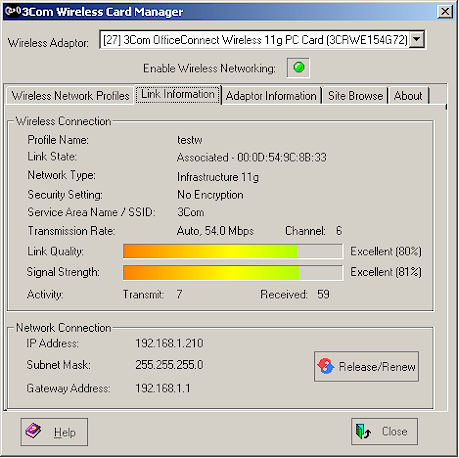
Figure 12: Card Manager
Although 3Com gets an “atta-company” for providing WPA-enabled drivers, the Card Manager program falls far short of past 3Com wireless client programs. The Manager barely covers the basics with the only settings available being SSID selection and WEP key setting (and channel number if you’re operating in AdHoc).
Missing are settings provided by other client mangers such as transmit rate, base rate, power save, transmit power, mode (11b, 11g), etc. Though the card’s Advanced Network Properties settings included some useful items such as Nitro and Power Save modes, since the Not Present radio button was selected on them all, I consider them unavailable.
I especially miss the ability to get signal-to-noise readings (both current and plots over time). Effective throughput rate (and time plots) would also be useful. I also didn’t care for the way the Manager buttons were presented, which made me think they were “greyed out” at first.
The client did interact well with Win XP Zero-Config, however, automatically disabling it whenever the manager was selected.
Wrap Up
Although not a bad product by any means, 3Com’s OfficeConnect Wireless 11g Cable/DSL Gateway seems uninspired. The feature set, though adequate for many users, lacks features such as schedulable filtering and WDS bridging that are found on other products from lesser-known (and smaller!) competitors. And wireless performance is average at best, with the disadvantage of non-upgradeable antennas.
The companion PC card has a generic-OEM qualilty about it, with neither software, performance, nor 3Com’s “X-Jack” antenna to distinguish it from competing products.
3Com – like many of its competitors – has had a difficult time during the past few years, but still seems to maintain its image as a premium networking brand. The good news is that the company seems to understand the pricing reality of today’s consumer and SOHO networking market and has priced the OfficeConnect 11g Gateway (and PC Card) to sell. But, judging from what I’ve seen in these products, I think 3Com needs to light a fire under its product designers to produce products more worthy of the company’s name.

